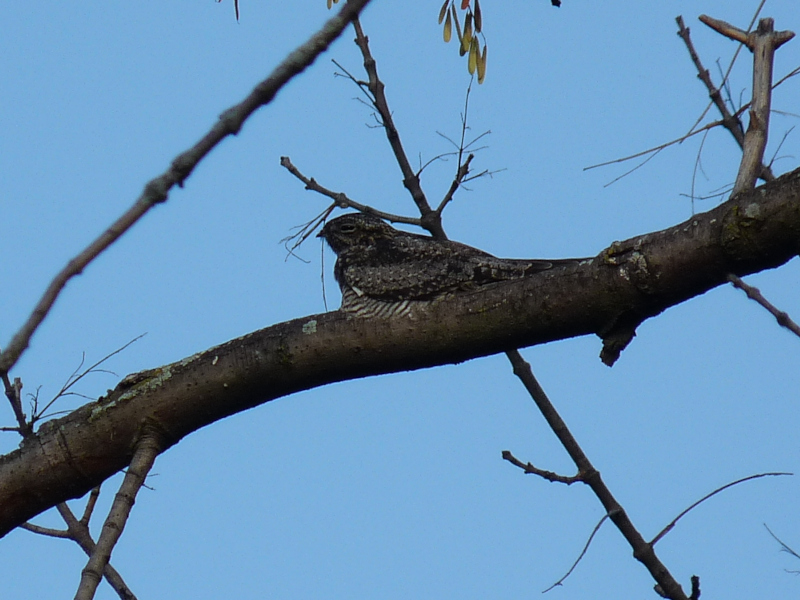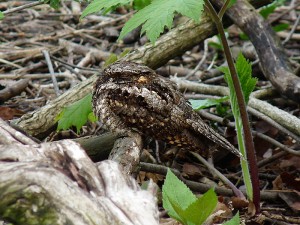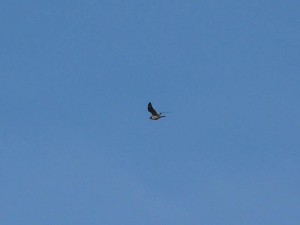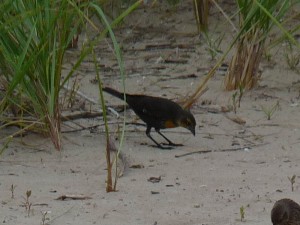Migrant Common Nighthawks are starting to show up in the Chicago area. We usually see large numbers of them, sometimes in the hundreds or more, moving south in late afternoon and evening in late August and early September. Seeing one perched is a different matter. Like other nightjars, Common Nighthawks are cryptically colored and when they perch they don’t move, all but disappearing. A good way to find them is to examine bare, horizontal tree limbs on trees that don’t have a lot of leaves. I’ve used this method with some success at Montrose. You may have to look at a lot of trees to find a roosting nighthawk but the effort will be worth it when you find one. They’re also easy to photograph.
Tag Archives: Common Nighthawk
The Sweet Season, May 9, 2019
The sweet season has commenced. Days like May 9 make suffering through Chicago winters worth it. I don’t know if the volume of birds was better than the fantastic weekend of May 4-5 but the variety certainly was. I tallied 95 species in about 3.5 hours of morning birding, my best spring total to date (according to eBird, over 120 species were reported). My highlights include 3 Black-bellied Plovers, Willet, Lesser Black-backed Gull, Common and Forster’s Terns, a roosting Common Nighthawk, 5 woodpeckers, 19 species of warblers (Pine, Northern Parula, and Blue-winged being the best), and Clay-colored Sparrow. Link to my eBird checklist below.
eBird Checklist
https://ebird.org/view/checklist/S56042131
May 11, 2016
I was at Montrose from 6 to 8 this morning and it was impressive. I don’t know if this constituted a fallout but there were a lot of birds around. I almost didn’t go out because of the thick fog (.25 mile visibility), but I was curious if the fog had downed any birds. The warblers weren’t the best I’ve ever seen but still good (I ended up with 22 species), but the tanagers, grosbeaks, and thrushes were
excellent. There was definitely turnover compared to the last few days. Here’s a rundown of what I saw (not a complete list; for a complete list follow the eBird link below):
Common Nighthawk – 1 perched on the outer branches of a Honey Locust (!)
Black-billed Cuckoo – 1
Great Crested Flycatcher – ~6
Least Flycatcher – ~10
Eastern Kingbird – ~15, some in groups of 4 and 5
White-eyed Vireo – 1
Yellow-throated Vireo – 1
Philadelphia Vireo – 1
Red-eyed Vireo – ~5
Ruby-crowned Kinglet – ~12
Blue-gray Gnatcatcher – ~12
Eastern Bluebird – 1
Wood Thrush – 1
Veery – ~6
Swainson’s Thrush – ~40
Gray-cheeked Thrush – 3
Gray Catbird – ~50, they seemed to be everywhere
Blue-winged Warbler – 1
Golden-winged Warbler – 1
Orange-crowned Warbler – 3
Nashville Warbler – 2
Tennessee Warbler – ~5
Northern Parula – 2
Chestnut-sided Warbler – ~5
Cape May Warbler – ~5
Magnolia Warbler – ~15
Yellow-rumped Warbler – ~15
Black-and-white Warbler – 2
Black-throated Blue Warbler – 1 male
Black-throated Green Warbler – 2
Bay-breasted Warbler – 1
Palm Warbler – ~25
Canada Warbler – 1
Common Yellowthroat – ~40
Wilson’s Warbler – 1
Ovenbird – 2
Northern Waterthrush – ~6
American Redstart – ~8
Scarlet Tanager – ~12, some in groups of 3 and 4
Savannah Sparrow – ~20
Swamp Sparrow – ~40
Lincoln’s Sparrow – 2
White-crowned Sparrow – ~40
White-throated Sparrow – ~25
Rose-breasted Grosbeak – ~12
Indigo Bunting – ~8
Bobolink – 1
Orchard Oriole – 1 immature male
Baltimore Oriole – ~12
Pine Siskin – 1
eBird Checklist
http://ebird.org/ebird/view/checklist?subID=S29565588
Common Nighthawk, October 10, 2015
Yellow-headed Blackbird, August 27, 2013
A Yellow-headed Blackbird, probably an immature male, was on the beach inside the protected area at Montrose this morning.
Other birds seen at Montrose this a.m. include 2 flyby juvenile Forster’s Terns, 3 Semipalmated Plovers, and a flyover Common Nighthawk.
If you go to Montrose at this time of the year I wouldn’t recommend wearing short pants as the flies can be particularly vicious.





